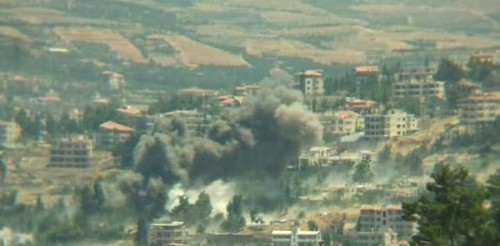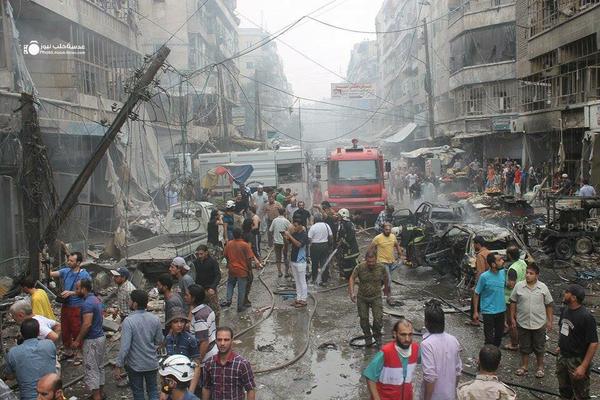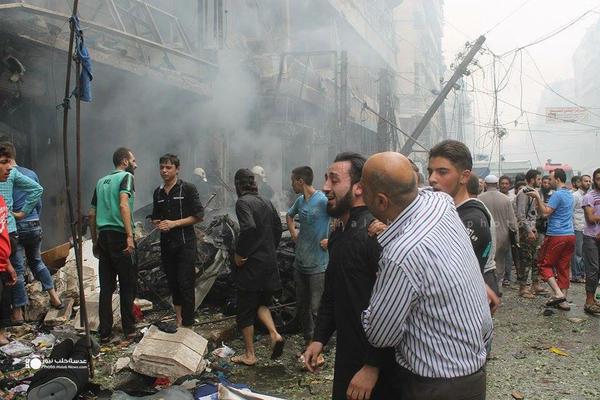PHOTO: Syrian air force bombardment of Zabadani, northwest of Damascus, in July
LATEST
- At Least 20 Killed by Regime Airstrike on Aleppo Neighborhood
- Netanyahu: Israel and Russia Will Coordinate Military Actions to Avoid Accidental Clashes
- Rally in Baniyas in Western Syria for Russian Military Intervention
- Video: Rebel Vehicle Bomb on Islamic State in Aleppo Province
- Iran’s President Rouhani: “We Will Talk About Constitution and Regime — After Terrorists Are Defeated”
- State Media: 14 Killed in Aleppo by “Terrorist” Shelling on Sunday
- Germany, Backing US Call for “Political Solution”, Welcomes Russia’s Military Intervention
- Details of Russian Warplanes Sent Into Syria
- Rebels Deny Unsupported Report of “75 More US-Trained Fighters” Entering Syria
MONDAY FEATURE
- Developing: Russia’s Pretext for Action Against Rebels? “Our Embassy Was Hit by Mortar Fire”
- Journalist Zaina Erhaim — Why I’m Not Able to Leave Aleppo Despite “Constant Death”
UPDATE 0600 GMT: A rebel spokesman has denied that an agreement has been reached beyond the short-term ceasefires in the northwest and south of Syria.
Abo Ameen said on Twitter that “nothing was concluded” and the report was “inaccurate”.
ORIGINAL ENTRY: After months of attacks and sieges, the Assad regime — through its ally Iran — and Syria’s rebels have suddenly agreed to ceasefires covering areas in both the northwest and south of the country, according to reports.
The ceasefires, in a document posted on Sunday night, cover Zabadani in Damascus Province — where Hezbollah and regime forces have tried for more than 80 days to take the town against unexpectedly tough rebel resistance — and the regime’s enclaves of al-Fu’ah and Kafraya, north of Idlib city.
See Syria Developing: Reports of Major Ceasefire Agreement Between Rebels and Regime
The Jaish al-Fateh rebel coalition renewed its assault on al-Fu’ah and Kafraya last week, threatening to overrun the long-isolated enclaves. It soon took territory to the north, northeast, and south of al-Fu’ah.
On Saturday, Ahrar al-Sham, the largest faction among rebels, offered a halt in the attacks if the Hezbollah-regime offensive on Zabadani was ended and rebels and any remaining civilians were evacuated.
Early Sunday, Iranian officials and rebels agreed to a specific, 48-hour ceasefire in the two areas.
Then the 25-point ceasefire, to be monitored by the UN, was reached after rebel factions reportedly agreed to the terms negotiated by Ahrar al-Sham. In addition to rebel coalitions, it is to be observed by the Islamist faction Jabhat al-Nusra.
The halt in fighting also covers towns close to Zabadani, such as Madaya; Baqeen, and Sarghaya. Rebels, wounded, and any civilians left in Zabadani must go to Idlib Province.
Women, children under 18, and men above 50 can leave Foua and Kafraya but the number is limited to 10,000. The regime will also release 500 prisoners, and blockades will be lifted on both the regime enclaves and the areas in Damascus Province.
Perhaps most significantly, the Assad regime will stop aerial attacks on Idlib city and nearby towns like Binnish, Taftanaz, and Maarat Misrin. As journalist Hassan Hassan noted, this is in effect the first de facto no-fly zone in Syria, following almost four years of deadly bombings and missile strikes that have propped up President Assad and the Syrian military.
The view from Tal Khirbet, captured by rebels this weekend, toward al-Fu’ah:
Rebels move on the regime defense line near al-Fu’ah:
Who “Wins”?
If the agreement is confirmed, the immediate outcome appears to be a significant victory for rebels. While Hezbollah and the Assad regime can now control Zabadani, the first town taken by the Free Syrian Army in January 2012, the town was likely to fall at some point because of the attrition of the attacks and siege.
However, while Hezbollah gets an extension of the buffer zone that it is seeking from the Lebanese border to Damascus, the regime does not get the quick victory that it was seeking to offset rebel advances this spring and summer.
Instead, through the threat of force against two regime enclaves, rebels have gotten a de facto acceptance that they now have long-term control of much of northwest Syria. And, if the Assad regime sticks to the deal to refrain from aerial attacks on part of Idlib Province — including the capital in Idlib city — the opposition has achieved a major breakthrough: for the first space, it has the space to develop governance and authority, free from the relentless bombardment on infrastructure and killing of civilians.
However, the victory brings further questions. With populations effectively being transferred, is the ceasefire the first step to a de facto partition of Syria, with the opposition in its mini-State in the northwest and the Assad regime surviving along a defense line from the Mediterranean to Homs to Damascus?
And if so, what happens to areas that do not cleanly fit that partition? What will be the fate of Syria’s largest city, Aleppo, divided between regime and rebels since July 2012? Will rebels confine themselves to the area of southern Syria that they hold and not move on Damascus? And what of territory held by the Kurds and the Islamic State, from northeast Syria to the center of the country?
At Least 20 Killed by Regime Airstrike on Aleppo Neighborhood
At least 20 people were killed in Aleppo city on Monday by a regime airstrike, according to the pro-opposition Local Coordination Committees.
The LCC said the attack was on the al-Shaar section of the divided city.
A resident said, “This is a public market and all of these people were shopping. Every time he [President Assad] suffers a defeat, he takes it out on civilians.”
Netanyahu: Israel and Russia Will Coordinate Military Actions to Avoid Accidental Clashes
Visiting Moscow, Israeli Prime Minister Benjamin Netanyahu has said that Israel and Russia have agreed to coordinate military actions over Syria to avoid accidental clashes.
Speaking with Israeli reporters after he met Russian President Vladimir Putin, Netanyahu said he had come with the goal to “prevent misunderstandings between IDF [Israel Defense Force] units and Russian forces”. The Prime Minister asserted that he and Putin “agreed on a mechanism to prevent such misunderstandings”.
Netanyahu was accompanied by the head of Israel’s armed forces and the general in charge of Israeli military intelligence.
In a signal to Russia to avoid operations near Syria’s Golan Heights, part of which were seized by Israel after the 1967 war, Netanyahu delcared Israel’s policy of striking at fighters suspected of preparing to attack it from the mountains.
A former Netanyahu adviser said any understandings reached with Putin “could come down to Israel and Russia agreeing to limit themselves to defined areas of operation in Syria, or even that they fly at daytime and we fly at night”.
Putin assured Netanyahu, “All of Russia’s actions in the region will always be very responsible,” condemning “all shelling of Israel”. He said he understood the Prime Minister’s concerns, but “we know that the Syrian army is in a situation such that it is incapable of opening a new front”.
The Russian President implied that rebels were responsible for any attacks on the Israelis: “As far as I know, makeshift missile systems are used.”
US officials said on Monday that Russia had started flying surveillance missions with drone aircraft inside Syria.
Rally in Baniyas in Western Syria for Russian Military Intervention
A citizen journalist has told Syria Direct of a rally in Baniyas, in Tartous Province in western Syria, celebrating the escalation of Russian military intervention.
“The rally carries a clear message that Russia is the force that will protect the regime’s presence and keep it in power,” Mohammed al-Banyasi said. “[It] is representative of most of the regime supporters in the cities on the [Mediterranean] coast.”
Banyasi also said Russian soldiers were stationed at regime checkpoints between Latakia and the Basel al-Assad military airport, which is receiving Moscow’s troops and supplies, “to oversee and secure the process of transporting weapons”.
Iran’s President Rouhani: “We Will Talk About Constitution and Regime — After Terrorists Are Defeated”
Speaking on prime-time US television about the crisis in Syria, Iran’s President Rouhani has said: “How is possible that we fight the terrorists of this country without supporting and helping the Government?…How can we fight the terrorists without the Government staying?”
He added:
Of course, after we have fought terrorism and a secure environment is created, then it is time to talk about the Constitution or the future regime….Opposition groups and supporters sit at a table.
But during a situation of bloodshed and during occupation of the country, what options exist?
See Iran Video: President Rouhani’s Interview on Prime-Time US Television
Iran Daily, Sept 21: Rouhani Promotes Nuclear Deal, But Cautious on Iran-US RelationsVideo: Rebel Vehicle Bomb on Islamic State in Aleppo Province
A weekend vehicle bomb by the rebel faction Jabhat al-Asalah wat-Tanmiyah against an Islamic State position in Herbel in Aleppo Province:
Rebels and the Islamic State have been locked in a months-long battle along a widespread front in the province.
State Media: 14 Killed in Aleppo by “Terrorist” Shelling on Sunday
State media says that 14 civilians, including seven children, were killed in “terrorist” shelling of a regime neighborhood in Aleppo city on Sunday.
A “police source” said the al-Midan district in the city, divided since July 2012, was struck. State news agency SANA said eight other people were injured, some critically, in a mortar attack on the al-Said Ali neighborhood later on Sunday.
State media has claimed that dozens of civilians have been killed in “terrorist” attacks in Aleppo this month.
Meanwhile, the Syrian air force continues to bombard opposition-held areas — claimed footage of an attack on Monday on the Bustan al-Qasr area:
Germany, Backing US Call for “Political Solution”, Welcomes Russia’s Military Intervention
Germany has backed the US acceptance of Russia’s initiative for a “political solution” in Syria.
German Foreign Minister Frank-Walter Steinmeier met US Secretary of State John Kerry in Berlin on Sunday. He said afterwards that he appreciated Kerry’s communications with Moscow and then endorsed Moscow’s expanding military intervention.
German Foreign Minister Steinmeir, after talks with Kerry, on Syria: "I strongly welcome…the growing military engagement of Russia"
— Liz Sly (@LizSly) September 20, 2015
Steinmeier added that Saudi Arabia and Iran should also be involved in a solution to the crisis.
Details of Russian Warplanes Sent Into Syria
The Oryx Blog, a leading observer of warplanes and weapons in the Syrian conflict, has posted an analysis of Russian aircraft entering Syria in the past week as part of Moscow’s escalatoing military intervention.
The website documents that Su-24 and Su-30 fighter jets have been escorted by refuelling planes across Syrian airspace. Airlifters have also brought in at least two Mi-17 and two Mi-24 helicopters.
A Russian cargo plane and five fighters above Homs Province on Sunday:
The Russians are expanding an airfield in Latakia Province in western Syria that previously housed about a dozen of the regime’s naval helicopters.
Oryx notes, “The Su-30SM [fighter jet] brings with it capabilities previously unavailable to the [Syrian Air Force, and will allow the Russian Air Force to closely follow any offensives or defensive actions.” The fighter can act as a “flying command platform” as well as an attacking warplane.
Rebels Deny Unsupported Report of “75 More US-Trained Fighters” Entering Syria
Leading rebel blocs have denied an unsupported claim, spread by a British-based “monitoring group”, that another 75 US-trained fighters have entered northern Syria from Turkey.
The Syrian Observatory for Human Rights, whose recycling of rumors as well as information is often used by mainstream media, said on Sunday that the fighters entered Aleppo Province between Friday night and Saturday morning.
However, the Sham Front and the Free Syrian Army’s Suqour al-Jabal brigade said on Sunday night that the report was untrue.
The Observatory claimed a convoy of a dozen cars had carried the men, light weapons and ammunition, with air cover from a US-led coalition. The convoy supposedly crossed through the Bab al-Salama border point, the main gateway for fighters and supplies into Aleppo province.
Last week, the head of US Central Command admitted to a Congressional hearing that a $500 million US program to train and equip rebels to fight the Islamic State, authorized last autumn, had failed.
General Lloyd Austin said “only four or five” troops, of the 54 finally put into Syria after more than 15,000 fighters applied for the program, were still in northern Syria.
Within days of their entry from Turkey in late July, the host for the fighters, the Free Syrian Army’s Division 30, was attacked by the Islamist faction Jabhat al-Nusra. The commander, his deputy, and 16 other troops were abducted. Jabhat al-Nusra then attacked Division 30’s headquarters, killing and capturing more soldiers.



